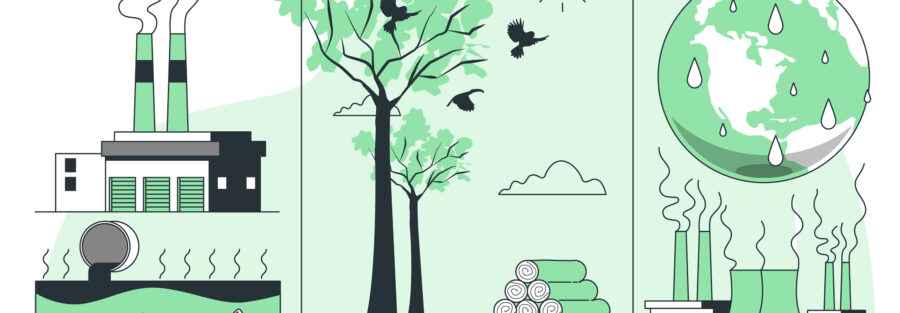Greenvissage explains, How does Europe’s Carbon Tax affect India?

As climate change becomes an increasingly urgent global issue, countries worldwide are stepping up their efforts to reduce carbon emissions. One of the most ambitious and far-reaching measures taken in this regard is the European Union’s (EU) Carbon Border Adjustment Mechanism (CBAM). This new carbon tax, set to be fully implemented by 2026, is set to have significant implications for global trade—and particularly for India’s export-heavy industries. In this article, we explore how the EU’s CBAM will affect India, its industries, and the country’s broader economic and political landscape. The Carbon Border Adjustment Mechanism (CBAM) is a new policy introduced by the European Union designed to address “carbon leakage.” Carbon leakage occurs when companies move their operations to countries with less stringent environmental regulations to avoid higher carbon taxes. To prevent this, the EU plans to impose a carbon tax on imports of carbon-intensive goods, such as steel, aluminium, cement, fertilizers, and electricity.
Under CBAM, goods imported into the EU from countries outside its borders will be taxed based on the amount of carbon emissions produced during their production. This tax will mirror the cost that EU-based companies face under the EU’s existing Emissions Trading System (ETS), where they must buy carbon credits to offset their emissions. The goal of CBAM is to level the playing field by ensuring that foreign companies are subject to the same environmental standards as European businesses, preventing the incentive to relocate production to low-regulation countries. For India, this new carbon tax presents a significant challenge. The country is a major exporter of carbon-intensive goods, particularly in sectors like steel, iron, aluminium, and cement—industries that are heavily reliant on coal and other fossil fuels. According to recent statistics, in 2022, 27% of India’s steel, iron, and aluminium exports, valued at approximately $8.2 billion, were sent to Europe. These sectors are expected to face higher costs under the new tax, making their goods less competitive in the European market.
Take steel, for example. Indian steel production, like that of many developing countries, relies heavily on coal-based technologies such as blast furnaces. These methods are carbon-intensive, meaning that Indian steel exporters, such as JSW Steel and Tata Steel, will need to buy CBAM certificates to offset the carbon emissions generated during production. Since India does not yet have a carbon pricing system like the EU, the additional cost of these certificates will make Indian steel more expensive in Europe, thus reducing the competitiveness of Indian exports. The financial burden of CBAM could result in a reduction of Indian exports to the EU, with some estimates suggesting a potential 10.5% drop in exports of carbon-heavy goods like steel, aluminium, and cement. For Indian companies that already face rising costs due to factors like inflation and fluctuating commodity prices, the added expense of CBAM could pose a serious challenge.
The EU’s carbon tax may catalyze change in India’s industrial practices, but the road to a greener future is fraught with challenges. While Indian companies like JSW Steel are already investing in cleaner technologies such as green steel production, the shift away from coal-based technologies will require significant investments. The transition to greener production methods, such as using hydrogen-based steel production, is costly and will take time to implement. Many Indian industries, particularly steel and cement, remain reliant on carbon-intensive processes, and the abrupt introduction of CBAM could put them at a disadvantage compared to European companies that already have more advanced technologies in place.
For India to effectively compete in the global market while meeting its climate goals, the country will need substantial investments in renewable energy, clean technologies, and infrastructure. However, India has limited access to international climate finance and technology transfers, which makes this transition particularly challenging. The country has estimated that it will need around USD 28 billion per year to meet its net-zero target by 2070, but international funding has largely been insufficient. This financial gap exacerbates the difficulties Indian industries face as they work to reduce emissions and align with global climate goals.
References:
- The Economic Times – EU’s carbon tax could cost India 0.05 per cent of GDP: Report
- Reuters – India sees EU carbon tax proposal as unfair and not acceptable, official says
- Image by storyset on Freepik
Greenvissage Explains, Can BRICS+ Currency Defeat the US Dollar?

The global financial landscape has long been dominated by the US dollar. It is the world’s primary reserve currency, used in international trade, and investment, and as a store of value by central banks. However, in recent years, the emergence of the BRICS+ (Brazil, Russia, India, China, and South Africa, along with several other nations) has sparked debates about whether these countries could create an alternative to the dollar that might challenge its dominance. In this article, we will explore the possibility of a BRICS+ currency defeating the US dollar, examining the challenges, potential benefits, and global implications of such a move. The US dollar’s global dominance is rooted in a variety of factors. The most significant of these is the size and strength of the US economy, which has made it a reliable and stable currency for international trade and investment. The dollar is also the currency in which commodities like oil, gold, and other vital resources are priced. In addition, most global reserves are held in US dollars, providing a built-in demand for the currency. The Bretton Woods system, established after World War II, further cemented the dollar’s role as the world’s reserve currency. Under this system, many nations agreed to peg their currencies to the US dollar, and the dollar itself was pegged to gold. Though the gold standard was abandoned in 1971, the US dollar continued to benefit from the financial system’s reliance on it, including being the dominant currency for international trade and the issuance of debt.
In recent years, BRICS+ has discussed the possibility of creating a new reserve currency or a common currency for trade among its members. This idea has gained traction as these nations increasingly seek to reduce their dependence on the US dollar in international trade and finance. For example, Russia and China have signed agreements to conduct bilateral trade in their local currencies, bypassing the dollar altogether. Similarly, India, Brazil, and other BRICS+ nations have signalled interest in exploring alternatives to dollar-based systems. While the BRICS+ countries collectively represent a significant portion of the global economy—about 40% of the world’s population and nearly a quarter of global GDP—they are far from unified in terms of economic strength. China, the largest economy in the group, accounts for a large share of BRICS+ GDP, while Brazil and South Africa face significant economic challenges, including inflation, unemployment, and political instability. India’s economy, though growing rapidly, still faces considerable structural hurdles. A common currency or a BRICS+ alternative to the US dollar would require considerable economic coordination and stability among member states. One of the key challenges is the diversity of economic conditions among BRICS+ countries. For example, China and India are both growing rapidly, while Brazil and South Africa are struggling with slow growth and debt issues. Economic disparities could make it difficult to implement a currency or trade system that suits all members.
Creating a BRICS+ currency would also require overcoming significant geopolitical hurdles. The member nations of BRICS+ do not always share the same foreign policy objectives, and their interests often diverge. For instance, China and India have a complicated relationship, marked by territorial disputes, while Russia’s relationship with Western nations has been increasingly hostile, especially in the wake of the Ukraine conflict. Moreover, the US dollar is not just a currency; it is a tool of US geopolitical influence. The US wields enormous power through its control over the global financial system, particularly via institutions like the SWIFT payment network and the US-dominated International Monetary Fund (IMF). Any attempt to challenge the dollar would face resistance from the US, which could leverage economic sanctions or other forms of pressure to preserve its dominance.
China has been the most proactive member of BRICS+ in pushing for alternatives to the dollar. The Chinese yuan (renminbi) has been steadily increasing its presence in global trade, finance, and reserves. China’s Belt and Road Initiative (BRI) has also played a role in encouraging the use of the yuan in international transactions, particularly in Asia and Africa. However, the yuan still faces significant hurdles in becoming a global reserve currency. Despite its growing influence, the yuan is not fully convertible and is subject to heavy government controls. Furthermore, it lacks the depth and liquidity of the US dollar’s financial markets. While China has taken steps to promote the international use of the yuan, it is unlikely that the yuan will dethrone the US dollar in the short term.
References:
- Financial Express – Putin’s BRICS Mock-Up Bill Sparks Debate, But No New Currency Yet
- Nasdaq – How Would a New BRICS Currency Affect the US Dollar?
- Economic Times – US dollar dominance to end? BRICS launches symbolic banknote
- Image by Farming Portal
Greenvissage explains, Can Lab Grown Diamonds take over the World?
India has long held a special place in the global diamond industry, both as a major consumer and as the world’s largest diamond-cutting and polishing hub. The Indian diamond market is one of the fastest-growing sectors in the global jewellery industry, with a cultural affinity for diamonds deeply rooted in celebrations, weddings, and luxury. However, recent advancements in technology have brought a new type of diamond to the forefront — artificial diamonds, also known as lab-grown or synthetic diamonds. These diamonds, which are chemically identical to their natural counterparts, are set to transform the Indian diamond industry in profound ways. Lab-grown diamonds are produced through two primary methods: High-Pressure High Temperature (HPHT) and Chemical Vapor Deposition (CVD). Both processes replicate the natural conditions under which diamonds are formed in the Earth’s mantle, but they do so in controlled laboratory environments. The result is a diamond that is indistinguishable from a natural diamond in terms of physical, chemical, and optical properties. While lab-grown diamonds have been around for a few decades, they have gained significant traction in the last 5 to 10 years, driven by technological advancements, increased awareness, and growing consumer demand for ethical and sustainable products. Unlike natural diamonds, lab-grown diamonds are produced without the environmental damage or ethical concerns associated with traditional diamond mining, such as human rights violations or ecological degradation. In India, where the diamond market is valued at billions of dollars, this shift is gaining momentum. The potential for artificial diamonds to take over the market is fueled by several factors, including cost-effectiveness, sustainability, and changing consumer preferences.
One of the most compelling reasons why artificial diamonds could revolutionize the Indian market is their significant cost advantage. Lab-grown diamonds are typically priced 20-40% lower than mined diamonds of the same size, clarity, and colour. This pricing differential presents an opportunity for consumers, especially in a price-sensitive market like India, to acquire larger or higher-quality diamonds for the same budget. In a country where the demand for diamonds is closely tied to weddings and special occasions, where people often purchase diamonds as an investment, the lower price point of artificial diamonds could make them more accessible to a broader demographic. This would be especially appealing to younger consumers, who may be more inclined to embrace the environmental and ethical appeal of lab-grown diamonds while still maintaining the desire for luxury and status symbol products.
India is one of the world’s largest consumers of gold and diamonds, but it is also increasingly becoming aware of the environmental and social impact of these industries. As consumers grow more eco-conscious, there is a rising preference for sustainable and ethically produced products. Lab-grown diamonds, with their minimal environmental impact and ethical sourcing, align perfectly with these concerns. Mining for natural diamonds is a resource-intensive process that often leads to deforestation, soil erosion, and the destruction of local ecosystems. Additionally, diamond mining in some regions has been linked to human rights violations, with conflict diamonds (or “blood diamonds”) fueling violence and exploitation. On the other hand, lab-grown diamonds are produced with significantly less environmental degradation, and many companies now offer transparent sourcing processes, ensuring that no harm is done to the planet or communities in their creation. In India, where environmental awareness is growing, particularly among the younger generation, lab-grown diamonds offer an ethical alternative that resonates with the country’s shifting values. The increasing popularity of sustainable brands, including in the fashion and jewellery sectors, further underlines the potential of artificial diamonds to capture a large share of the market.
The traditional allure of diamonds as symbols of love, commitment, and wealth is still strong in India. However, consumer preferences are evolving, and younger, more tech-savvy buyers are beginning to prioritize value, ethics, and transparency. Millennials and Gen Z, who are more likely to question traditional norms and practices, have shown a growing interest in ethical luxury. This demographic is also more likely to embrace the concept of lab-grown diamonds as they challenge conventional perceptions of what constitutes “real” luxury. Social media influencers, celebrities, and brands championing sustainable and ethical luxury are also playing a significant role in educating Indian consumers about lab-grown diamonds. Internationally, celebrities like Meghan Markle and Leonardo DiCaprio, who have supported ethical and environmentally friendly practices, have helped raise awareness about lab-grown diamonds. This has led to a broader acceptance of synthetic diamonds as a legitimate choice for luxury, including in India. Additionally, the growing trend of customization in the jewellery industry allows consumers to design their pieces with lab-grown diamonds. The flexibility of design, combined with affordability, further positions lab-grown diamonds as a viable option for a new generation of buyers.
References:
- LiveMint – Lab-grown Diamonds: Goldiam leads the charge, Trent joins the race
- Times of India – Lab-grown diamonds: The future is here?
- Your Story – hining bright: The rise of lab-grown diamonds in India
Greenvissage explains, Can Starlink survive in the Indian Telecom Market?

SpaceX’s ambitious satellite internet project, Starlink, has generated significant excitement globally, and its potential entry into India has stirred up both curiosity and debate. The service promises to offer high-speed internet access through a constellation of low Earth orbit (LEO) satellites, potentially revolutionizing internet connectivity, especially in rural and remote areas where traditional broadband infrastructure is either sparse or non-existent. However, while Starlink’s promise of faster and more reliable internet is alluring, there are several factors—ranging from regulatory challenges to competition and pricing—that could determine whether the service can truly thrive in the Indian market. Starlink, operated by SpaceX, aims to provide internet connectivity to underserved regions around the world by using a network of thousands of small satellites in Low Earth orbit (LEO). Unlike traditional broadband services that rely on ground-based infrastructure like fibre optic cables, Starlink uses a constellation of satellites that communicate directly with user terminals, allowing for internet access even in the most remote areas.
Starlink’s satellite constellation is designed to cover every corner of the globe, including areas where traditional internet infrastructure is impractical or prohibitively expensive to build. Starlink’s satellites operate in low Earth orbit (LEO), which reduces the latency compared to traditional satellite internet services, making it suitable for high-bandwidth activities like video conferencing, gaming, and streaming. One of the most promising aspects of Starlink is its potential to bridge the digital divide in rural India, where internet access remains a significant challenge. By bypassing the need for physical infrastructure, Starlink could provide fast and reliable internet to millions of people who are otherwise cut off from the digital economy. Despite the promising outlook, several challenges could hinder Starlink’s success in India. The entry of any foreign company, particularly in sectors like internet services, requires navigating complex and often bureaucratic regulations. In 2021, Starlink’s plans to begin services in India were temporarily halted by the Department of Telecommunications (DoT), which expressed concerns about the company offering services without the necessary licenses. The government requires foreign companies like Starlink to obtain licenses to provide satellite-based communication services in India. While Starlink is making efforts to comply with these regulations, the complex process of obtaining approvals, operating permits, and ensuring compliance with the country’s legal framework could slow its rollout. Moreover, the Indian government has pushed for “Made in India” initiatives across many sectors, including technology. The requirement for Starlink to use locally manufactured equipment or partner with Indian companies could add to its operational costs and delay its deployment. India’s telecom market is fiercely competitive, with established players like Jio, Airtel, and Vi already offering affordable internet services across the country. These companies have built extensive infrastructure over the years, including fibre optic cables, 4G, and 5G networks, making them formidable competitors. For Starlink to gain a foothold, it would have to offer compelling advantages over these established services. While satellite internet has the potential to provide high-speed internet in rural areas, the cost of setting up and maintaining the necessary infrastructure (like satellite dishes and user terminals) could be a significant hurdle for Starlink.
Affordability is a key issue in India, where the cost of internet access is a major factor influencing adoption rates. India’s telecom tariffs are among the lowest in the world, with data prices that are significantly cheaper than in many other countries. For instance, Jio’s plans provide users with 1GB of data for as little as INR 10 (USD 0.12). In contrast, Starlink’s initial setup cost, including the dish and modem, can run into several thousand dollars, with ongoing monthly fees of around USD 110-120. For the average Indian consumer, these prices are unaffordable, particularly in rural areas where income levels are lower. While Starlink’s pricing may become more competitive as its technology matures and it scales up its operations, it will need to address this affordability gap if it aims to capture a significant market share in India.
References:




